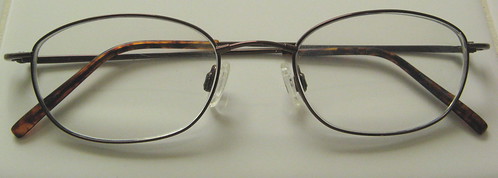I just got these new spectacles — had to bow to advancing decrepitude and switch to bi-focals (nothing like walking around feeling like you’re on hallucinogens all day) — and one thing I noticed was how surpassingly light they are. One-half of an ounce, or 15 grams, according to the ol’ postal scale.
Of course your mileage will vary according to your fashion tastes and how blind you are, but it sure seems to me that lenses and frames have gotten a lot lighter of late. I went with the “Transitions” lenses, which colorize in response to ultraviolet rays of the sun. They darken extremely quickly, which is nice if you forget your regular sunglasses (they don’t darken in the car, however, because the windows and roof block UV rays).
I’m eager to see how these work under tree cover. My regular prescription sunglasses are polarized, which reduces glare but gives the eye an unrealistic idea of what the woods actually look like, which can lead to disappointing snapshots. It all looks so pretty behind the shades, but the actual pictures come out comparatively bland.
Your eyeglass observations are welcome.


One thing I have discovered after entering this “visually-challenged” stage of life is that bifocals (or “progressive lenses”) don’t always work well for hiking. The unfortunate issue is that your feet and the trail are right in the area optimized for close focus.
I generally use single-vision glasses for serious hiking these days.
Dan
Unlike Dan, I’ve been very happy with progressive lenses on the trail. My problem is the first few minutes after coming back indoors.
For years I switched back-and-forth between sunglasses and regular. It’s a treat to only carry one pair now.